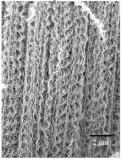

Clemson University and the University of California San Deigo have teamed together to develop a novel process to create HCNTs and helically coiled carbon nanowires (HCNWs) in one step with high yield. Previous methods to produce HCNTs suffered from the need for a preformed patterned substrate and low yield due to suboptimal catalyst distribution and the co-production of straight, uncoiled CNTs. The novel process uses a liquid precursor method and proprietary hydrocarbon catalyst mixture, and is mostly free of straight or spherical carbon nanoparticles that typically contaminate HCNTs . They explain that the coiled structures result from the use of indium catalysts that form repulsive interactions with the nanostructure during formation, unlike the attractive interactions that form using typical catalysts. One of the team members, Professor Rao of Clemson University, indicates that their process yields enough HCNTs for large scale production and does not require prefabrication of a patterned substrate such that it could be transformed economically to the industrial scale.
These researchers showed that helically coiled carbon nanowires could be produced similarly simply by changing the catalyst from indium to tin and the rate that the precursor/catalyst mixture is introduced into the reactor. These researchers also pointed out other applications of the helical nanostructures that have been studied previously by others, including use of helical nanostructures as templates for collagen growth and as dual metallic-semiconducting materials for nanoelectronics.
Additional information:
Wang, et al. Rational Synthesis of Helically Coiled Carbon Nanowires and Nanotubes through the Use of Tin and Indium Catalysts. Advanced Materials 2008 20 179. Copyright Wiley-VCH Verlag GmbH & Co. KGaA. Reproduced with permission.
